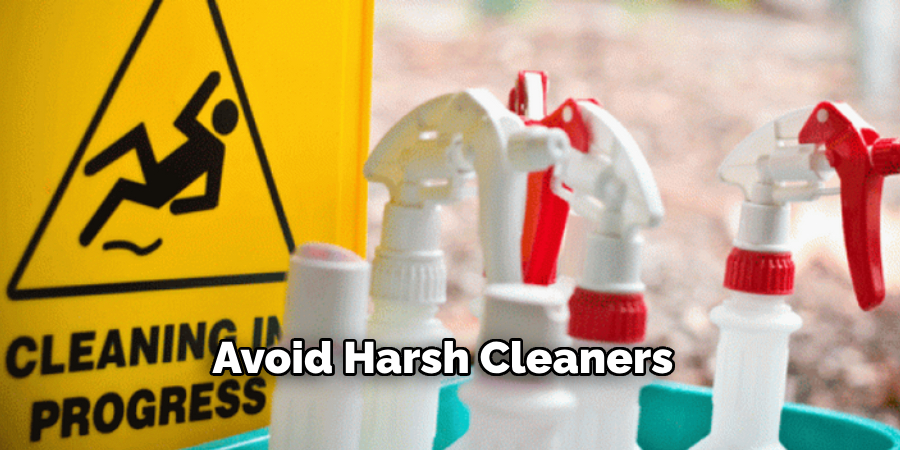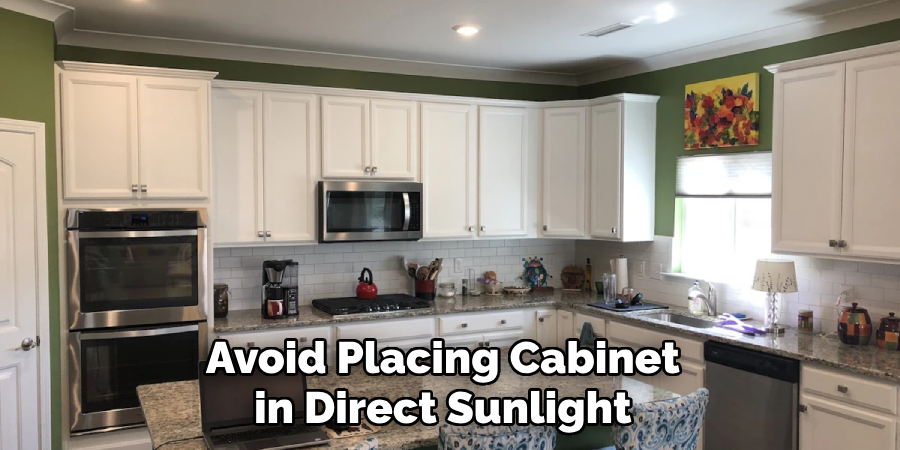Painted cabinets can significantly enhance the aesthetic of any kitchen or living space, providing a fresh look and vibrant color to your surroundings. However, these beautiful finishes require proper care and protection to maintain their appearance and durability over time.

In this guide on how to protect painted cabinets, we will explore effective strategies to safeguard your painted cabinets from scratches, chips, and fading, ensuring they remain a stunning focal point in your home for years to come. Whether you have newly painted cabinets or are looking to preserve older ones, these tips will help keep them looking their best.
Why Protect Painted Cabinets?
Before we dive into the methods of protecting painted cabinets, let’s first understand why it is necessary. Painted cabinets are susceptible to wear and tear due to their constant use in high-traffic areas such as kitchens or bathrooms. They can easily get scratched, chipped, or stained from spills, heat exposure, and moisture. In addition, UV rays from sunlight can cause fading and discoloration of the paint, making it lose its original vibrancy. If left unprotected, these damages can compromise the appearance and lifespan of your cabinets.
It is also essential to protect painted cabinets because they are a significant investment. Repainting or replacing cabinets can be costly, and preserving them will save you both time and money in the long run.
6 Easy Step-by-step Guides on How to Protect Painted Cabinets
Step 1: Clean and Prep
The first step in protecting your painted cabinets is ensuring they are thoroughly cleaned and prepped. Begin by removing any dust, grease, or grime that may have accumulated on the surfaces. Use a soft cloth or sponge and a gentle cleaning solution, such as mild dish soap mixed with warm water. Avoid harsh chemicals that could damage the paint.

Once cleaned, rinse the cabinets with a damp cloth to remove any soap residue, and dry them gently with a clean, dry towel. This preparation will create a clean slate for any protective measures you plan to apply, ensuring better adhesion and effectiveness. Remember to focus on areas that are prone to buildup, such as around handles and in corners, to achieve a comprehensive clean.
Step 2: Apply a Protective Coat
After cleaning and drying, it is time to apply a protective coat on your painted cabinets. There are various options available, such as polyurethane, wax, or varnish. These coatings act as a barrier between the cabinet surface and potential damages, including scratches and moisture.
Before application, make sure to read the manufacturer’s instructions carefully and choose an appropriate product for your type of paint. Use a brush or roller to apply thin layers evenly in the direction of the grain of the wood. Let each layer dry completely before applying another one if needed.
Step 3: Consider Adding a Sealant
In addition to a protective coat, you may want to consider adding a sealant for extra protection. Sealants are specially formulated products that penetrate and seal the painted surface, providing an additional layer of defense against moisture, stains, and fading.
Like protective coats, make sure to choose a sealant suitable for your type of paint and read the instructions carefully before application. Apply thin layers using a clean cloth or brush and let each coat dry thoroughly.
Step 4: Use Drawer Liners
Drawer liners may seem like a small detail, but they play an essential role in protecting your painted cabinets from scratches. They act as a cushion between items placed in drawers and the cabinet’s surfaces, preventing direct contact that can cause scratches or damage to the paint.
Choose liners made of soft, non-adhesive materials that will not stick to your cabinets and are easy to remove for cleaning if needed. Measure and cut them to fit precisely inside the drawers.
Step 5: Protect Against Heat
Heat can be damaging to painted cabinets, so it is crucial to take precautions against it. Avoid placing hot items directly on cabinet surfaces by using trivets or potholders when cooking and serving food. Consider adding a heat-resistant pad under small appliances like coffee makers or toaster ovens that sit on your cabinets’ surface.

You can also use heat-resistant paint or add a protective sheet to the back of your cabinets’ doors if they are exposed to heat from appliances or stovetops.
Step 6: Avoid Direct Sunlight
As mentioned earlier, UV rays from sunlight can cause fading and discoloration of painted cabinets. To protect against this, try to keep your cabinets away from direct sunlight as much as possible. If your kitchen or living space has large windows that let in a lot of light, consider using curtains or blinds during peak hours of sunlight. If you have no choice but to place your cabinets in direct sunlight, make sure to regularly rotate items on display to avoid uneven fading.
Following these simple steps on how to protect painted cabinets will help protect your painted cabinets and extend their lifespan. Remember to also perform regular maintenance, such as wiping down surfaces with a soft cloth and gentle cleaner, to keep them looking their best. With proper protection and care, your painted cabinets will continue to bring joy and beauty into your home for years to come
Tips for Protecting Painted Cabinets
Use Protective Coatings:
One of the most effective ways to safeguard painted cabinets is by applying protective coatings such as polyurethane or varnish. These sealants create a barrier between the cabinet surface and external elements, preventing scratches, stains, and UV damage.
When choosing a protective coating, ensure it is compatible with your paint type and finish. For example, water-based polyurethane is suitable for water-based paints, while oil-based polyurethane works best with oil-based paints. You can also opt for a clear coat or colored topcoat to enhance the appearance of your cabinets.
Avoid Harsh Cleaners:
Harsh cleaning products can damage the finish of painted cabinets, causing them to deteriorate over time. It is crucial to use gentle cleaners specifically designed for painted surfaces. Avoid products that contain ammonia, bleach, or other harsh chemicals as they can strip the paint and cause discoloration.
When cleaning your cabinets, use a soft cloth or sponge and mild dish soap diluted in warm water. Rinse thoroughly and dry with a clean cloth immediately after.

Handle with Care:
One of the simplest ways to protect painted cabinets is by handling them with care. Avoid slamming cabinet doors and drawers, as this can cause chips and cracks in the paint. Use gentle pressure when opening and closing them, and ensure knobs and handles are securely attached to prevent any mishaps.
Maintain a Suitable Environment:
Humidity can be damaging to painted cabinets, causing the wood to expand or contract, leading to cracking and peeling of the paint. It is essential to maintain a suitable environment by keeping humidity levels between 40-50%. You can use a dehumidifier or air conditioner to control humidity levels.
Also, avoid placing cabinets near heat sources such as stoves or ovens, as the constant exposure to heat can cause the paint to fade and crack.
Regular Maintenance:
Regular maintenance is key to protecting painted cabinets. Inspect them periodically for any signs of damage or wear, and address them immediately. Touch up any chips or scratches using touch-up paint or a small artist’s brush. Wipe down your cabinets regularly with a soft cloth to remove dust and prevent buildup.
Frequently Asked Questions
Q1: Can I Use Wax to Protect Painted Cabinets?
A: While wax can provide some protection, it is not as durable as other sealants and may need frequent reapplication. It is best to use a protective coating specifically designed for painted surfaces.
Q2: How Often Should I Clean Painted Cabinets?
A: It is recommended to clean painted cabinets once a week with a mild cleaner and warm water. However, you can do it more frequently if necessary, such as after cooking or when spills occur.
Q3: What Can I Do to Prevent the Fading of Painted Cabinets?
A: To prevent fading of painted cabinets, avoid placing them in direct sunlight and use protective coatings that contain UV inhibitors. You can also install curtains or blinds to block out excess sunlight.

Q4: Can I Repaint Already Painted Cabinets?
A: Yes, you can repaint already painted cabinets. However, it is essential to properly prepare the surface by sanding and removing any old paint or finish before applying a new coat of paint. This will ensure a smooth and long-lasting finish.
Conclusion
Painted cabinets are a beautiful addition to any home, but they require proper protection and care to maintain their appearance and durability. By following these tips on how to protect painted cabinets, you can ensure your painted cabinets remain in top condition for years to come. Remember, prevention is better than cure when it comes to protecting your cabinets, so be proactive in maintaining and safeguarding them. Keep these strategies in mind, and you can enjoy your stunning painted cabinets for years to come!
About the Author
Adrian Green, a lifelong woodworking enthusiast, shares his passion for the craft through The Woodenify Blog. With a foundation built on years of hands-on experience in his father’s woodworking shop, Adrian is dedicated to helping others learn and grow in the world of DIY woodworking. His approach to woodworking combines creativity, practicality, and a deep appreciation for the art of building with your own hands. Through his blog, he inspires individuals of all skill levels to embark on their own woodworking journeys, creating beautiful, functional pieces of furniture and décor.
Professional Focus
- Specializes in DIY woodworking projects, from furniture to home décor.
- Provides step-by-step guides and practical tutorials for woodworkers of all skill levels.
- Dedicated to helping readers build confidence and skill through easy-to-follow instructions and tips.
- Passionate about fostering a community of makers who can share, learn, and grow together.
Education History
- University of Craft and Design – Bachelor of Fine Arts (BFA) in Woodworking and Furniture Design
- Woodworking Apprenticeships – Extensive hands-on training with skilled craftsmen to refine carpentry and furniture making techniques.
- Online Courses & Masterclasses – Continued education in advanced woodworking techniques, design principles, and specialized tools
Expertise:
- DIY woodworking, carpentry, furniture making, and home décor projects.
- Creating accessible tutorials and guides for beginner to advanced woodworkers.
- Sharing the joys and satisfaction of woodworking, from raw materials to finished products.
